The Gordon Ramsay Beef Wellington is an iconic dish known for its tender beef filet wrapped in layers of savory duxelles, prosciutto, crepe, and puff pastry. While it may seem intimidating, with the right approach, you can recreate this show-stopping meal at home. Whether you’re hosting a special occasion or just looking to challenge yourself in the kitchen, these expert tips will guide you to master every element of this classic recipe.
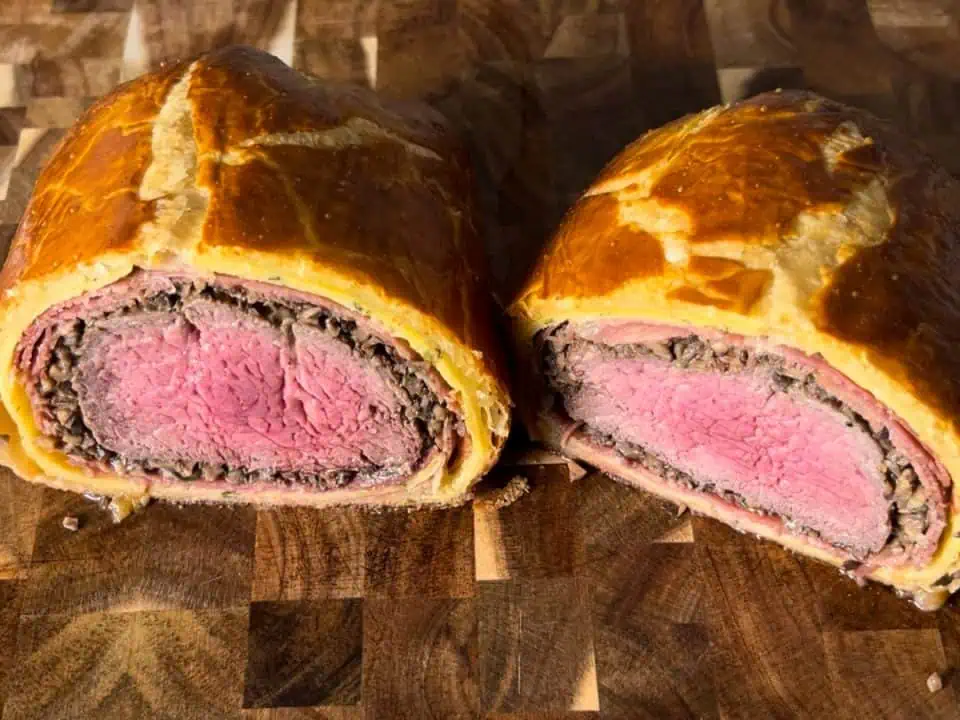
There are few dishes as elegant and luxurious as Beef Wellington. So when I decided to start throwing dinner parties, there was only one thing that had to be on the menu: Beef Wellington! Now, at that point, I had never even eaten it before. But I had seen so many episodes of Hell's Kitchen that I felt like I knew what it tasted like.
So what did I do? I took to YouTube to watch the man himself make it. Over and over and over again...
I mean, I must have watched those videos 30 times each. But I was determined to nail it!
And My First Results...
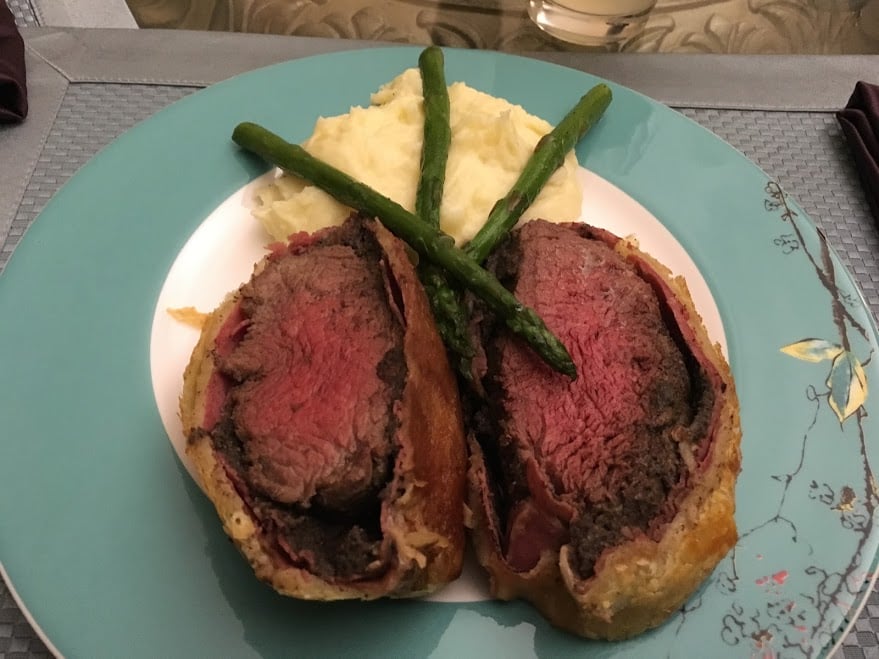
A mess. But actually, I was so proud of it. I made it 3 or 4 more times with the same loose, soggy result. Then, as I was watching a more recent season of MasterChef, I noticed something different. They were adding a layer of crepe! I'm not sure when (if ever) GR modified the recipe, but I found no record of it on his website where I got the original recipe (except in the photo, which I noticed while writing this) or in the YouTube tutorials. Until...
A few Christmases ago, I received the Gordon Ramsay Masterclass as a gift. My family knew this was the perfect gift for me, and I highly recommend the $90 investment. And low and behold, what did I find? The missing steps to the recipe!
It's all about the crepe. That layer will absorb the moisture and protect your puff pastry from becoming mush. The mushrooms are also prepared differently, which I definitely prefer. Now, I feel like a pro. But don't get me wrong... It is not necessarily hard, but it is a lot of work.
How to Make the Gordon Ramsay Beef Wellington
Wrap the Center-Cut Beef Tenderloin for the Perfect Shape
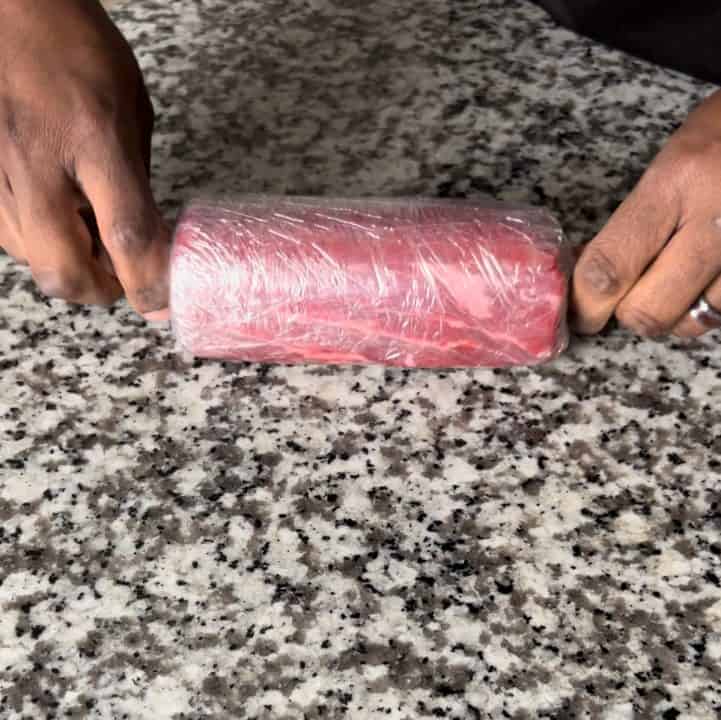
Letting it chill in the fridge for at least 15-20 minutes (overnight is best) helps the meat hold its shape. This step ensures the beef cooks evenly and remains compact during searing and baking, which is key for creating the signature look of Beef Wellington. It also makes it easier to wrap the tenderloin in the delicate layers of prosciutto and puff pastry later on. Skipping this step could lead to an uneven or misshapen Wellington.
Mastering the Mushroom Duxelles
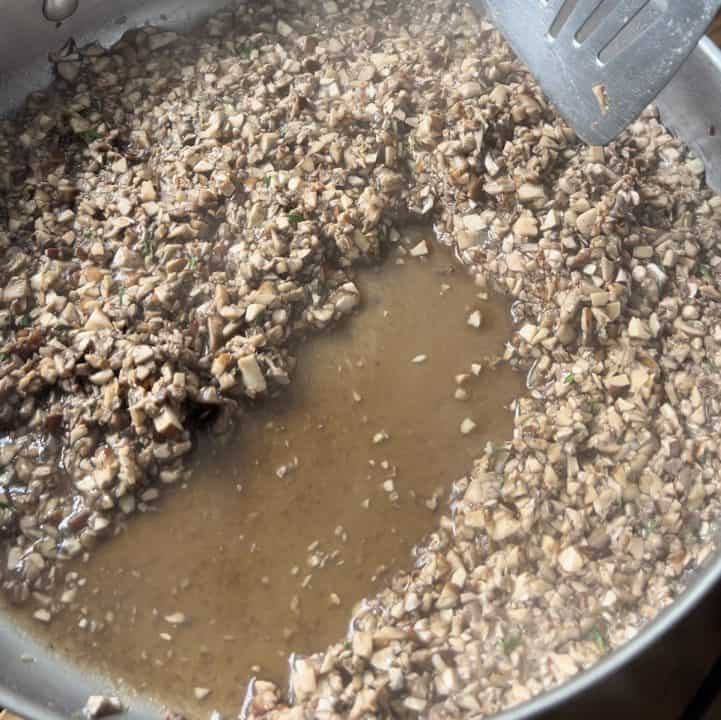
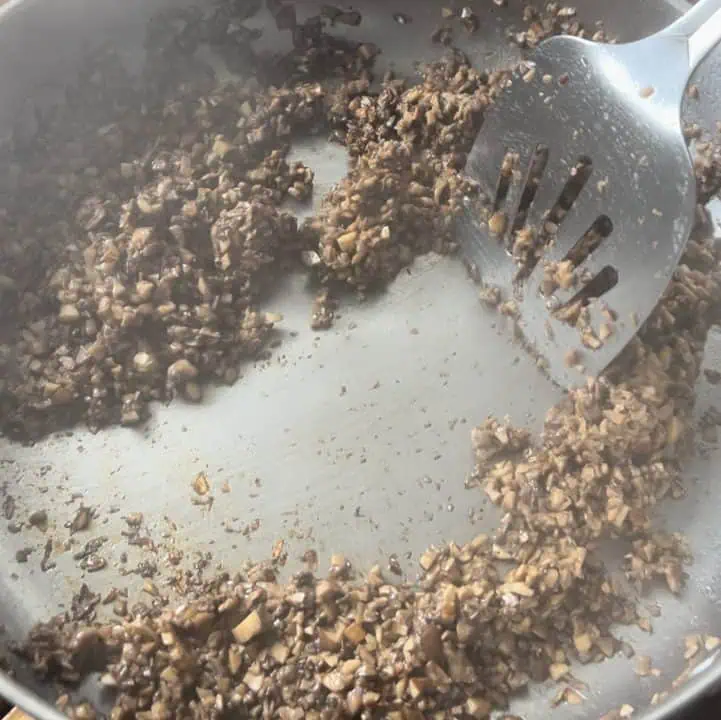
- Ingredients and Preparation:
- Start by finely dicing baby bella mushrooms. While some recipes suggest using a food processor, dicing the mushrooms by hand gives the duxelles a more textured, satisfying bite.
- Heat a couple of tablespoons of oil in a pan over medium heat before adding the diced mushrooms. The oil will help the mushrooms cook evenly and prevent them from sticking. Season with salt, pepper, and fresh thyme.
- The Key Step: Evaporating the Liquid:
- As the mushrooms cook, they will release a significant amount of liquid. Continue cooking them until all the moisture is released and fully evaporated. This step is crucial to avoid a soggy Beef Wellington, as any excess moisture could ruin the puff pastry.
- Cool Before Using:
- Allow the duxelles to cool fully before layering them. This will keep the pastry from becoming too soft.
Pro Tips:
- Cook off all the liquid: The most important thing to remember is to continue cooking the mushrooms until every bit of moisture is released and evaporated. A dry, concentrated mushroom mixture is the goal.
- Texture matters: Finely dicing the mushrooms instead of using a food processor ensures a better texture and prevents the duxelles from becoming too mushy.
Perfecting the Chive and Thyme Crepe Layer
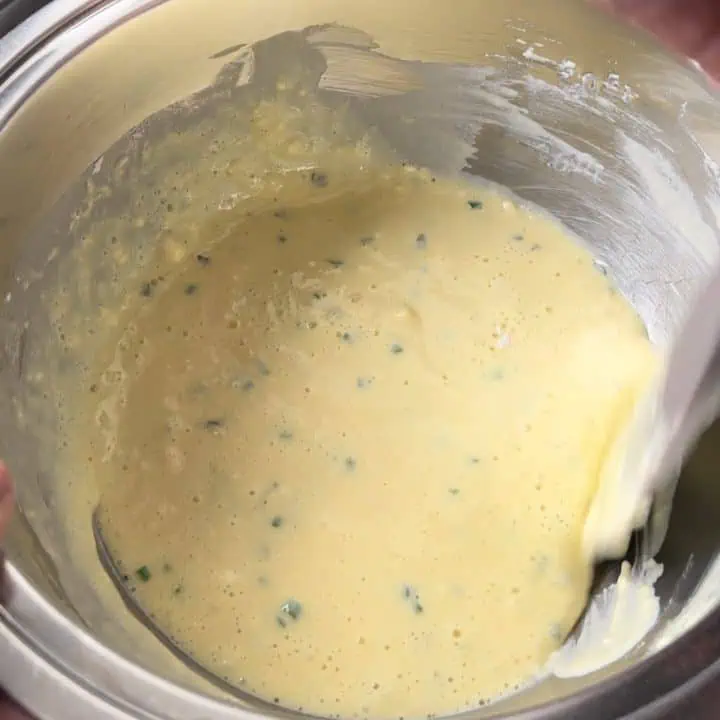
- Let the Batter Rest in the Fridge:
After mixing the batter for the crepes, it's important to let it rest in the fridge for about 30 minutes to an hour. Resting allows the flour to fully absorb the liquid, leading to a smoother, more cohesive batter. It also helps relax the gluten in the flour, making the crepes more tender and easier to work with. Without this resting period, the crepes might turn out tough or have a rubbery texture, affecting the final result. - Making Crepes as Thin as Possible:
To create the ideal thin crepes for Beef Wellington:- Use a nonstick or crepe pan: Heat the pan over medium heat, and lightly grease it with butter or oil.
- Control the batter amount: Pour a small amount of batter into the pan, just enough to lightly cover the bottom. Tilt and swirl the pan quickly to spread the batter thinly and evenly.
- Cook quickly: Thin crepes cook very fast. Let the batter set for about 30 seconds, then flip and cook for another 10-15 seconds on the other side. The goal is a delicate, paper-thin crepe.
Pro Tips:
- Consistency of the batter: Ensure the batter is smooth and slightly runny, like heavy cream. If it's too thick, add a bit of water or milk to thin it out before cooking.
- No sticking: Use minimal grease in the pan to prevent the crepes from becoming oily. They should be dry and light to act as a protective barrier in the Beef Wellington.
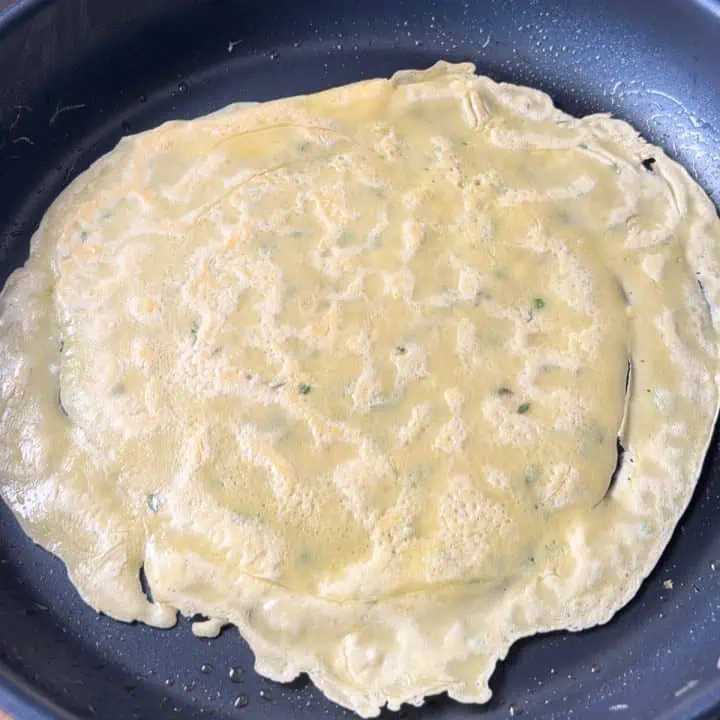
Searing the Beef for Perfect Crust
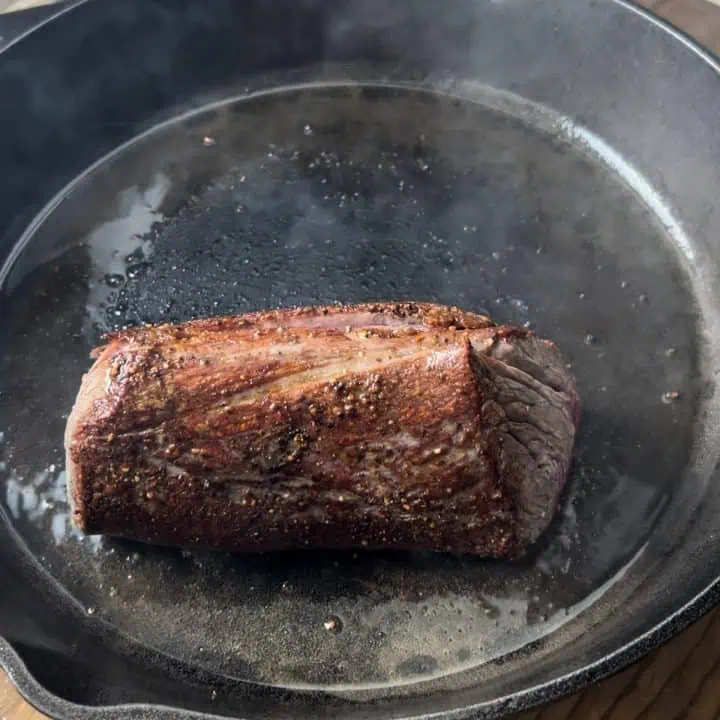
- Remove Plastic Wrap and Season Generously:
After chilling the beef tenderloin in the fridge, remove the plastic wrap and pat the beef dry with paper towels to remove any excess moisture. This helps the meat sear properly. Season the beef generously with salt and pepper on all sides. The seasoning will create a flavorful crust during searing and help the beef develop that rich, caramelized exterior. - Sear on All Sides, Including the Ends:
Heat a cast iron skillet over high heat until it’s smoking hot. Add a little oil with a high smoke point (such as avocado or grapeseed oil). Place the beef in the pan and sear each side for 60 seconds, including the ends. This brief, intense sear ensures the outside is browned while keeping the inside tender and rare.
Pro Tips:
- High heat is key: Ensure the pan is very hot before adding the beef to achieve a quick sear without overcooking the inside.
- Patience is crucial: Let each side sear undisturbed for the full 60 seconds to develop a deep crust. Moving the beef too much will prevent proper browning.
- Dry the beef: Always pat the beef dry before seasoning and searing to help it brown faster and avoid steaming in the pan.
Brushing the Beef with Dijon Mustard
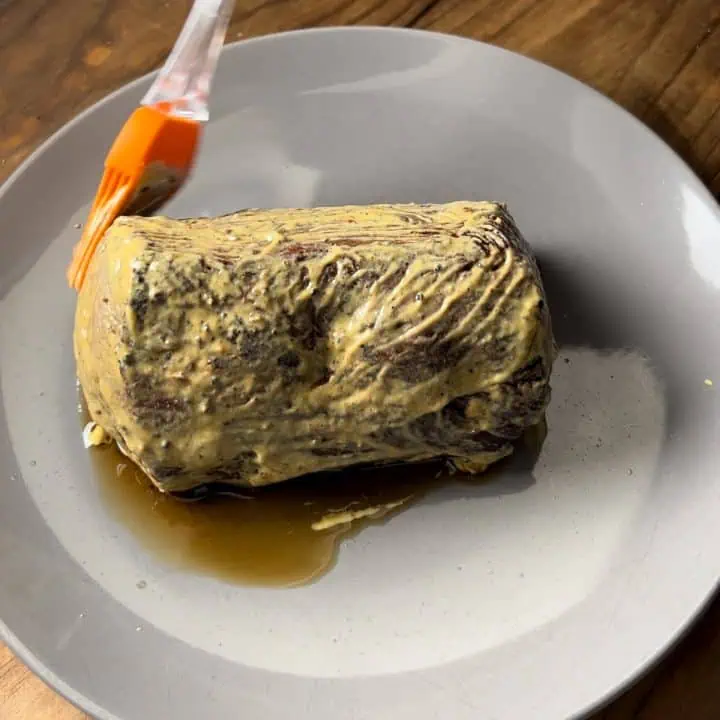
- Brush While the Beef is Hot:
It’s important to brush the Dijon mustard onto the beef immediately after searing while the meat is still hot. The heat helps the mustard adhere better to the beef and allows it to seep into the surface, infusing the tenderloin with its bold flavor. If you wait until the beef cools down, the mustard won’t stick as effectively, and you’ll miss out on the flavor absorption. - Be Generous with the Mustard:
Don’t hold back on the Dijon! This is the only acidic element in the entire Wellington, and it’s essential for cutting through the richness of the beef, duxelles, prosciutto, and puff pastry. The mustard adds a sharp, tangy contrast that brightens up the dish and prevents it from feeling overly heavy.
Pro Tips:
- Generous application: Make sure to coat all sides of the beef thoroughly with mustard, creating a flavorful layer that enhances the taste of each bite.
- Flavor balance: Dijon mustard’s acidity is key for balance. Without it, the Wellington can feel overly rich and lacking in brightness.
Trimming the Crepes to Fit the Beef
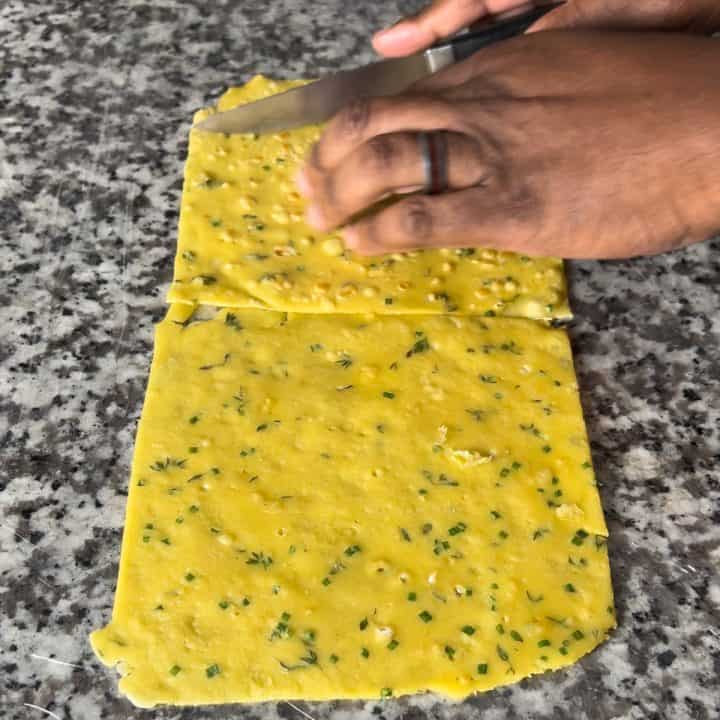
- Trim for a Perfect Fit:
Lay the crepes out flat and trim any excess crepe around the edges so that it perfectly wraps the beef without overlapping. The crepes should form a thin, even layer around the tenderloin, hugging it snugly. Excess crepe can create bulky layers that may affect the texture or cause uneven baking, leading to soggy spots in the final dish.
Pro Tips:
- Use a sharp knife: For precise trimming, use a sharp knife or kitchen scissors to carefully cut away the extra crepe.
- No overlapping: Make sure the crepes do not overlap. You want just enough coverage to enclose the beef without doubling up on the layers.
Layering the Crepe, Prosciutto, Mushrooms, and Beef
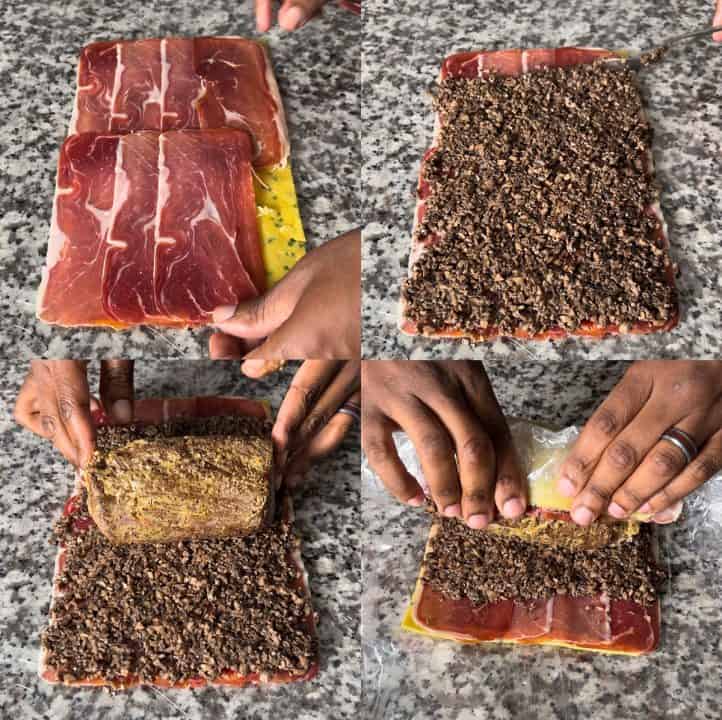
- Lay Out the Crepe:
Start with a chive and thyme crepe laid flat on a large piece of plastic wrap. This serves as the first protective layer and adds a subtle flavor to the dish. - Top the Crepe with Prosciutto:
Next, evenly lay slices of prosciutto over the crepe. Ensure the slices overlap slightly to create a solid layer that will hold the beef and mushrooms in place. The prosciutto adds a savory, salty element to the Wellington. The original recipe calls for four slices, but I use eight. - Spread the Mushrooms Over the Prosciutto:
Evenly spread the cooled mushroom duxelles over the prosciutto. This layer adds rich, earthy flavors and acts as a moisture barrier, helping to keep the pastry crisp. - Place the Beef on Top:
Carefully position the mustard-coated beef tenderloin in the center of the layered crepe, prosciutto, and mushrooms. This order ensures the beef is well-protected and surrounded by complementary flavors. - Wrap It All Tightly with Plastic Wrap:
Using the plastic wrap, carefully roll everything around the beef to form a tight package. Make sure the prosciutto and crepe fully encase the beef and mushrooms, securing all the layers together. - Let It Set in the Fridge:
Once wrapped, place the package in the refrigerator for at least 30 minutes. This chilling time helps the layers set and firm up, making it easier to handle when you’re ready to wrap the Wellington in puff pastry.
Importance of This Layering:
Each layer serves a purpose: the crepe prevents moisture from reaching the pastry, the prosciutto adds flavor, and the mushrooms provide richness. Together, they ensure that the Beef Wellington maintains its structure and flavor during cooking.
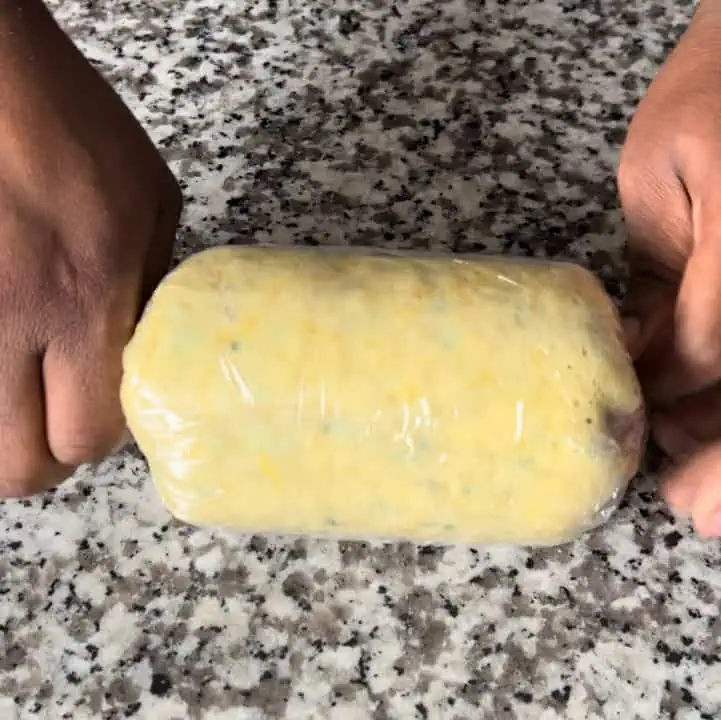
Wrapping the Wellington in Puff Pastry
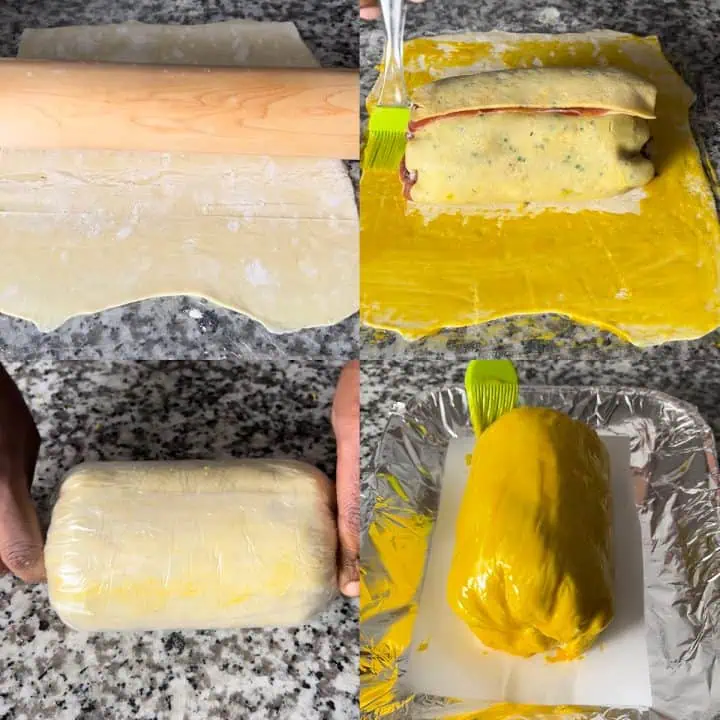
- Roll Out the Puff Pastry:
Start by lightly flouring your work surface and rolling out the puff pastry with a rolling pin. Aim for a large rectangle that’s about ⅛ inch thick. This ensures the pastry can fully encase the beef and create a beautiful, golden crust. - Place the Crepe Roll on Top:
Once the pastry is rolled out, carefully place the wrapped crepe roll in the center. Make sure it is positioned lengthwise, allowing enough pastry on either side for wrapping. - Brush with Egg Wash:
Brush the edges of the pastry all around with an egg wash (a mixture of beaten egg and a splash of water). This helps the pastry adhere to the crepe and seals the edges, preventing any moisture from escaping during baking. - Roll Tightly with Plastic Wrap:
Using the plastic wrap, carefully roll the puff pastry around the crepe and beef, forming a tight cylinder. Ensure that the seam is on the bottom to maintain an elegant presentation. The tight roll helps the pastry maintain its shape while baking. - Chill in the Fridge:
After rolling, let the wrapped Wellington chill in the refrigerator for about 30 minutes. This resting time helps the pastry firm up, making it easier to handle and ensuring a better rise during baking. - Remove from Fridge and Plastic Wrap:
Once chilled, take the Wellington out of the refrigerator and carefully unwrap it from the plastic wrap. - Brush the Outside with Egg Wash:
Brush the entire exterior of the puff pastry with the egg wash. This step is essential for achieving a beautiful, golden-brown color as it bakes. - Place on a Tray with Parchment Paper:
Transfer the Wellington to a baking tray lined with parchment paper. This prevents sticking and allows for even cooking. - Bake at 425°F:
Place the tray in a preheated oven at 425°F (220°C). Bake until the internal temperature reaches 135°F (57°C) for medium-rare. This should take about 35 to 40 minutes, but keep an eye on it to ensure the pastry is golden brown and flaky.
Importance of the Puff Pastry:
The puff pastry is essential for creating the iconic crust of the Beef Wellington. It encases all the flavorful layers inside while adding a delightful texture and visual appeal. Properly rolling, sealing, and baking the pastry will ensure that your Wellington turns out perfectly.
Resting the Wellington Before Slicing
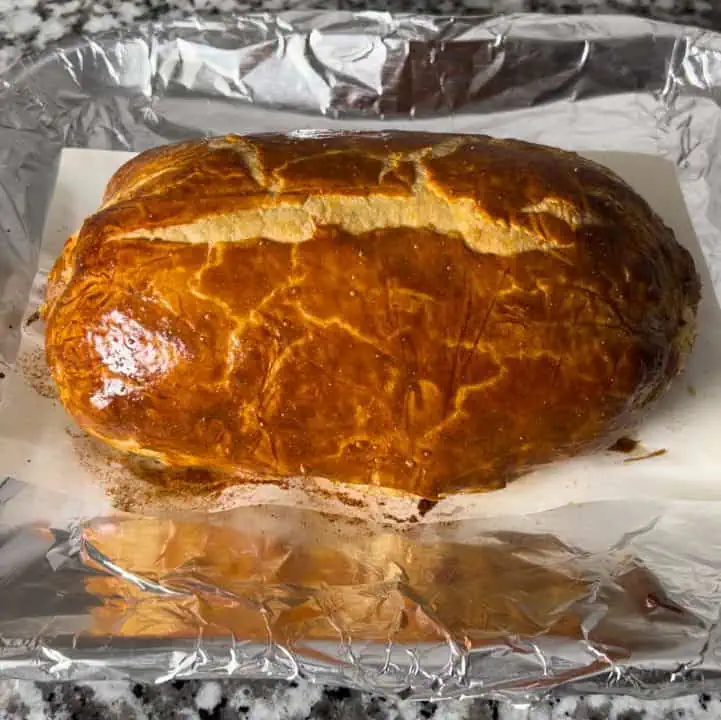
- Why Resting is Essential:
Resting the Wellington allows the juices inside to redistribute throughout the meat. If you slice into the Wellington immediately after baking, the juices will flow out, resulting in a dry interior. Resting helps maintain the tender, juicy texture of the beef, ensuring each slice is moist and flavorful. - How Long to Rest:
Allow the Wellington to rest for at least 15 to 20 minutes. This gives the meat ample time to stabilize and allows the layers to set. During this time, the pastry will also remain crisp while the filling cools slightly, making it easier to slice without compromising the structure. - Cover to Keep Warm:
If desired, you can lightly cover the Wellington with aluminum foil during the resting period to keep it warm. Be careful not to wrap it too tightly, as this can trap steam and soften the pastry. - Slicing the Wellington:
After resting, use a sharp, serrated knife to slice the Wellington into even portions. Aim for about 1-inch thick slices to showcase the beautiful layers of beef, mushrooms, prosciutto, and pastry.
Importance of Resting:
This resting step is a vital component of the cooking process, ensuring that your Beef Wellington is as juicy and delicious as possible. Patience during this stage will reward you with perfect, beautiful slices that highlight the intricate flavors and textures of this classic dish.
Now This is Gordon Ramsay Beef Wellington!
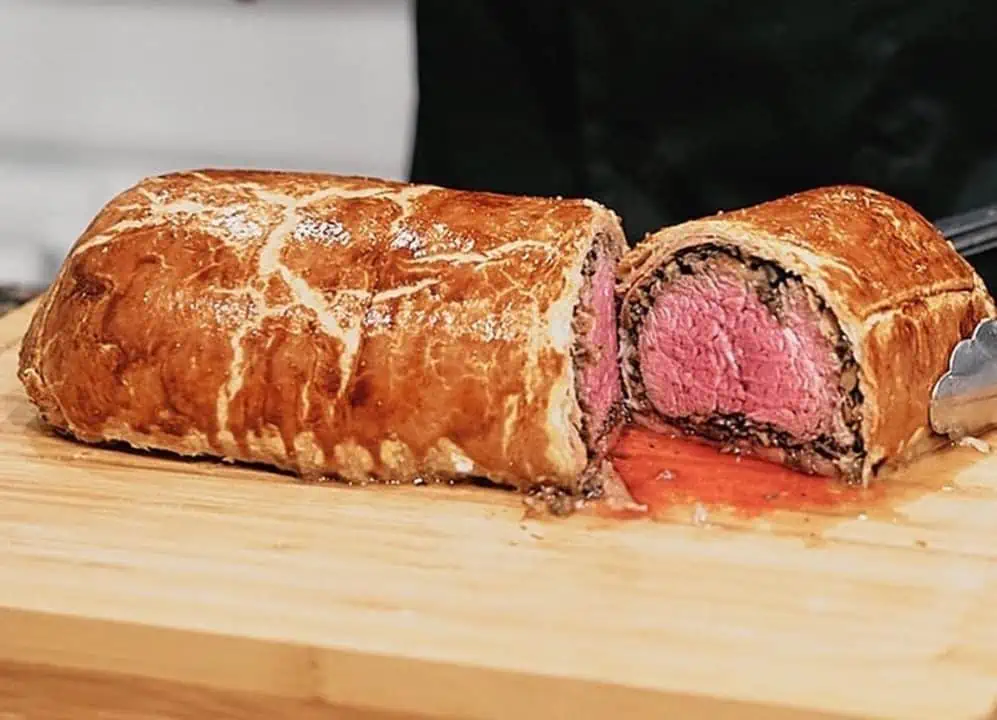
📖 Recipe
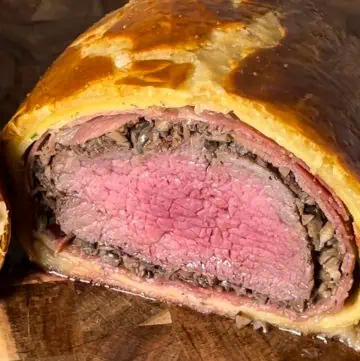
Gordon Ramsay Beef Wellington: How to Make It Perfectly
Ingredients
Mushroom Duxelles
- 2 Tbsp. olive oil
- 16 oz. baby bella mushrooms finely diced
- 1 tsp. sea salt
- ½ tsp. black pepper
- 1 tsp. thyme leaves
Crepes
- 1 large egg
- ½ cup all-purpose flour
- ½ cup milk
- ½ tsp. chives finely chopped
- ½ tsp. thyme leaves
- ¼ tsp. sea salt
Wellington
- 1 lb. center-cut beef tenderloin
- 2 tsp. sea salt
- 1 tsp. black pepper
- 2 Tbsp. grapeseed oil
- 2 Tbsp. Dijon mustard
- 8 prosciutto slices
- 1 puff pastry sheet thawed
- 4 egg yolks
Instructions
Prep the Beef Tenderloin
- Wrap the beef tightly in a triple layer of plastic wrap, shaping it into a neat cylinder. Let it chill in the refrigerator overnight to set its shape (or at least 30 minutes).
Make the Mushroom Duxelles
- Start by finely dicing baby bella mushrooms. While some recipes suggest using a food processor, dicing the mushrooms by hand gives the duxelles a more textured, satisfying bite.
- Heat a couple of tablespoons of oil in a pan over medium heat before adding the diced mushrooms. The oil will help the mushrooms cook evenly and prevent them from sticking. Season with salt, pepper, and fresh thyme.
- As the mushrooms cook, they will release a significant amount of liquid. Continue cooking them until all the moisture is released and fully evaporated.
- Set them aside and allow the duxelles to cool fully before layering them.
Make the Chive Crepes
- In a large mixing bowl, whisk together eggs, flour, milk, chives, thyme, and salt until smooth. Chill the batter in the fridge for at least 30 minutes.
- Heat a nonstick pan over low heat and lightly spray it with cooking oil. Add ¼ cup of the crepe batter, swirling the pan to spread it into a thin, even layer. Cook for about 25-30 seconds until the crepe is set, then carefully flip it and cook for just a few more seconds. The crepes should stay pale without browning. Remove and set aside. Repeat.
Sear and Season the Beef
- After chilling the beef tenderloin in the fridge, remove the plastic wrap and pat the beef dry with paper towels to remove any excess moisture. This helps the meat sear properly. Season the beef generously with salt and pepper on all sides.
- Heat a cast iron skillet over high heat until it’s smoking hot. Add a little oil with a high smoke point (such as avocado or grapeseed oil). Place the beef in the pan and sear each side for 60 seconds, including the ends.
- Once seared, transfer the beef to a tray and pour any juices from the pan over it. While the beef is still hot, brush it all over with Dijon mustard. Set aside to rest.
Assemble the Wellington
- Moisten a cutting board with a damp towel, then layer three pieces of plastic wrap, overlapping them. Trim 2 crepes into squares that match the length of your beef, and lay them out on the plastic wrap.
- Next, evenly lay slices of prosciutto over the crepe. Ensure the slices overlap slightly to create a solid layer to hold the beef and mushrooms in place.
- Evenly spread the cooled mushroom duxelles over the prosciutto.
- Using the plastic wrap, roll the beef tightly in the crepes, prosciutto, and mushrooms to form a neat package. Twist the ends of the plastic wrap to secure it, and chill in the fridge for 20 minutes.
Wrap in Puff Pastry
- Moisten the cutting board again and lay out three pieces of plastic wrap. Using a rolling pin, roll the puff pastry into an ⅛-inch-thick rectangle.
- Once the pastry is rolled out, carefully place the wrapped crepe roll in the center. Position it lengthwise, allowing enough pastry on either side for wrapping.
- Brush the edges of the pastry all around with an egg wash (a mixture of beaten egg and a splash of water).
- Using the plastic wrap, carefully roll the puff pastry around the crepe and beef, forming a tight cylinder. Ensure that the seam is on the bottom to maintain an elegant presentation. After rolling, let the wrapped Wellington chill in the refrigerator for about 30 minutes.
- Once chilled, take the Wellington out of the refrigerator and carefully unwrap it from the plastic wrap. Brush the entire exterior of the puff pastry with the egg wash. This step is essential for achieving a beautiful, golden-brown color as it bakes.
Baking, Resting, and Slicing
- Preheat your oven to 425°F for convection or 450°F for a regular oven.
- Transfer the Wellington to a baking tray lined with parchment paper. This prevents sticking and allows for even cooking.
- Place the tray in a preheated oven at 425°F (220°C). Bake until the internal temperature reaches 135°F (57°C) for medium-rare. This can take anywhere from 20 to 40 minutes, depending on your oven and the starting internal temperature of the beef.
- Remove the Wellington from the oven and allow it to rest for at least 15 to 20 minutes. If desired, you can lightly cover the Wellington with aluminum foil during the resting period to keep it warm. Be careful not to wrap it too tightly, as this can trap steam and soften the pastry.
- After resting, use a sharp, serrated knife to slice the Wellington into even portions. Aim for about 1-inch thick slices to showcase the beautiful layers of beef, mushrooms, prosciutto, and pastry.




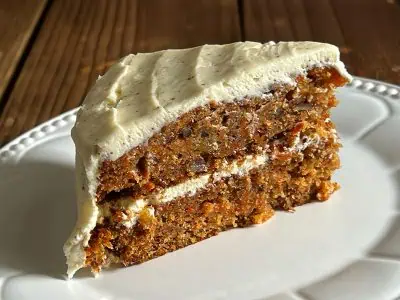

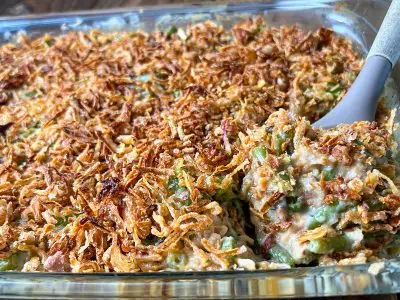
Corrine
Yum!!! Now, when can I host a dinner party?!
Chef Gary
Call me. Let's look at our calendars!
Pirate Chef
Wow man, looks awesome! Nice work on a hard dish! I've eaten it, but never attempted to cook it myself, it's sooooo fancy! I can't wait to see what's next!
Chef Gary
Thanks man. We still need to get you over here for dinner!
Cara Jae
Yummm.. looks amazing my talented friend!
Cara Jae
<3
Paige
I've always wanted to try to make that...I just might now. Thanks friend 🙂
Chef Gary
It is a show stopper! Good luck, and please share pics!
Jesse
I just ate lunch...read this article...drooled over the pictures...now, I am hungry again...as if I did not just eat 5 minutes ago. YUMMMMMYYYY
Chef Gary
? you're welcome!
Matthew
This thing was magical! Dare I say better than a plate of hot, crispy, greasy bacon? Yes, yes we are! Top notch Chef Gary! Keep them coming?
Jesse
Soooo...can we schedule a "dinner party" at my house on Thursday, November 23rd and Sunday, December 25th? LOL!
Chef Gary
I don’t know if you’re ready to pay the tax on those dates. ? However, we can schedule something else...
Morgan
Where is the recipe ?
Marianne
Waiting on the recipe................ ????
Marianne
Is there a recipe online for the Gordon Ramsay Beef Wellington?
Gary
Hi Marianne. In the post I link to this recipe: https://www.gordonramsay.com/gr/recipes/beef-wellington/ . However, the point of the post is to share that there is a step missing that they only share in the Master Class course; the crepe. Out of respect for Gordon Ramsay, I will not repost his recipe here, but you can find the recipe he has made public at the above link.
Marianne
If this is a duplicate QUESTION.... What is the ANSWER?
Solveig
What sort of crepe?
Gary White
Just a basic, simple crepe. I did add thyme to mine though.
Nisha
Can this recipe be prepared without using the parma ham? My guests don't eat pork.
Gary White
You could certainly switch out for different deli meat. One that has a big flavor, maybe like turkey pastrami?
Andrea
Wow. Great instructions. This is our favourite holiday meal. .
Katie Vaccaro
This was absolutely amazing. My second attempt at Welly's and they were perfect! The thyme and chive crepe was exactly what I missed last year!